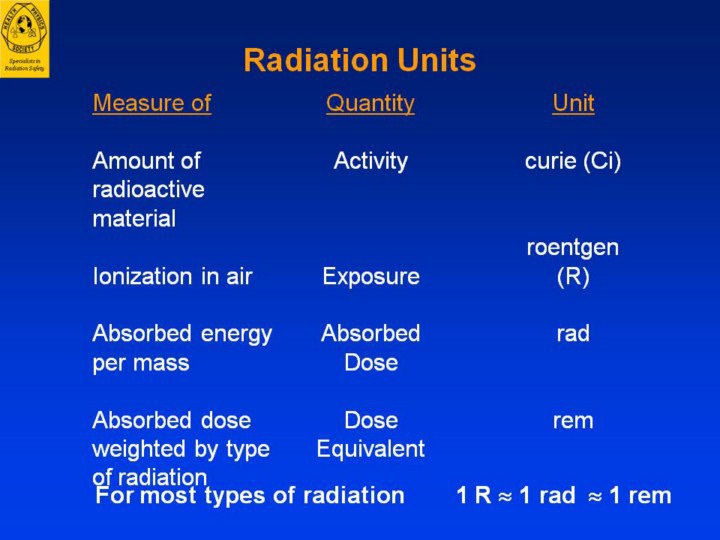| front |1 |2 |3 |4 |5 |6 |7 |8 |9 |10 |11 |12 |13 |14 |15 |16 |17 |18 |19 |20 |21 |22 |23 |24 |25 |26 |27 |28 |29 |30 |31 |32 |33 |34 |35 |36 |37 |38 |39 |40 |41 |42 |43 |review |
 |
Radiation Units
A
curie is a very large amount of radioactivity. Contamination of
individuals usually involve µCi to mCi quantities. Nuclear medicine
patients are injected with µCi to mCi quantities of radioactive material
for routine diagnostic exams.
The
basic unit of radiation dose is the rad. The rad is defined as the
deposition of 0.01 joule of energy (a small amount) per kilogram (kg) of
tissue.
A
rad of x-rays, a rad of gamma rays, and a rad of beta particles are
about equally damaging to tissue. However, a rad of another type of
ionizing radiation, such as alpha particles or neutrons, is much more
damaging to tissue than a rad of gamma rays.
The
rem was introduced to take into account this variation in tissue
damage. This is important because a person may be exposed to more than
one type of radiation. For example, it was found that 100 rad of gamma
and beta radiation produced the same effect as 100 rad of x-rays.
However, only 20 rad of neutrons and 5 rad of alpha particles produced
the same effect as 100 rad of x-rays. Therefore, neutron and alpha
radiations were more potent and required fewer rad to produce the same
effect.
The
number of rem is calculated by multiplying the number of rad by a
radiation weighting factor that accounts for the relative amount of
biological damage produced by a specific type of radiation. The
radiation weighting factor for x-rays, gamma rays, and beta particles is
1. Thus, a rad of one of these radiations is equal to one rem. For
other types of radiation (that are less likely to be present in
accidents), the quality factor may be higher.
The
International Scientific System (SI) assigns different units to the
quantities:
1 R = 2.58 X 10-4 C kg-1 1 gray (Gy) = 100 rad 1 sievert (Sv) = 100 rem 1 becquerel (Bq) = 1 disintegration per second |